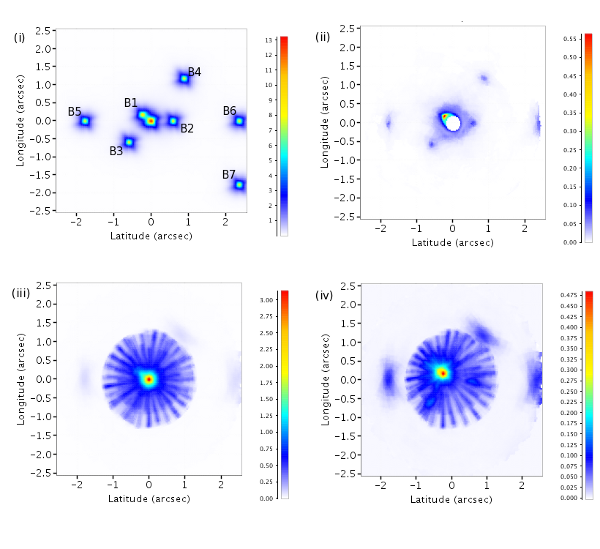IoW_20110920 - Gaia
Image of the Week |
A fast 2D image reconstruction algorithm from 1D data for the Gaia mission |
 |
|
Diana Harrison has presented a fast 2-dimensional image reconstruction method, which takes as input 1-dimensional data acquired from scans across a central source in different orientations. The resultant reconstructed images do not show artefacts due to non-uniform coverage in the orientations of the scans across the central source, and are successful in avoiding a high background due to contamination of the flux from the central source across the reconstructed image. Due to the weighting scheme employed this method is also naturally robust to hot pixels. This method was developed specifically with Gaia data in mind, but should be useful in combining data with mismatched resolutions in different directions. Diana Harrison's paper is available online at SpringerLink and astro-ph. Description of the picture: (i) This figure shows the sky in the vicinity of the primary located at (0,0) with the point sources convolved with the effective PSF, accounting for the coverage of the sky in different orientations. (Note, here all the secondaries sources have the same magnitude). (ii)-(iv) 2-D image reconstructions (using SM and AF2, 5 and 8 windows) around a primary of magnitude 18 with the source layout as in (i), where source B1 has a magnitude of 20, the remaining secondaries have magnitudes of 22. (ii) using the new method described in the paper (the primary is masked out with a disc of radius 0.2'' otherwise it dominates the colour scale). (iii) using the drizzle method. (iv) using drizzle, but subtracting (perfectly) the contribution of the primary from all the windows prior to reconstruction. In (iii) and (iv) one can see the problems created by the 1-dimensional AF windows in the form of linear artefacts, and one can see that subtracting the contribution of the primary does not eliminate this issue. credits: Diana Harrison [Published: 20/09/2011] |
- Removed a total of (3) style text-align:center;
- Removed a total of (10) style text-align:justify;
- Removed a total of (1) border attribute.
- Removed a total of (1) cellpadding attribute.
- Removed a total of (1) cellspacing attribute.
Image of the Week Archive
- Removed a total of (1) border attribute.
- Removed a total of (1) cellpadding attribute.
- Removed a total of (1) cellspacing attribute.








































 Sign in
Sign in
 Science & Technology
Science & Technology
